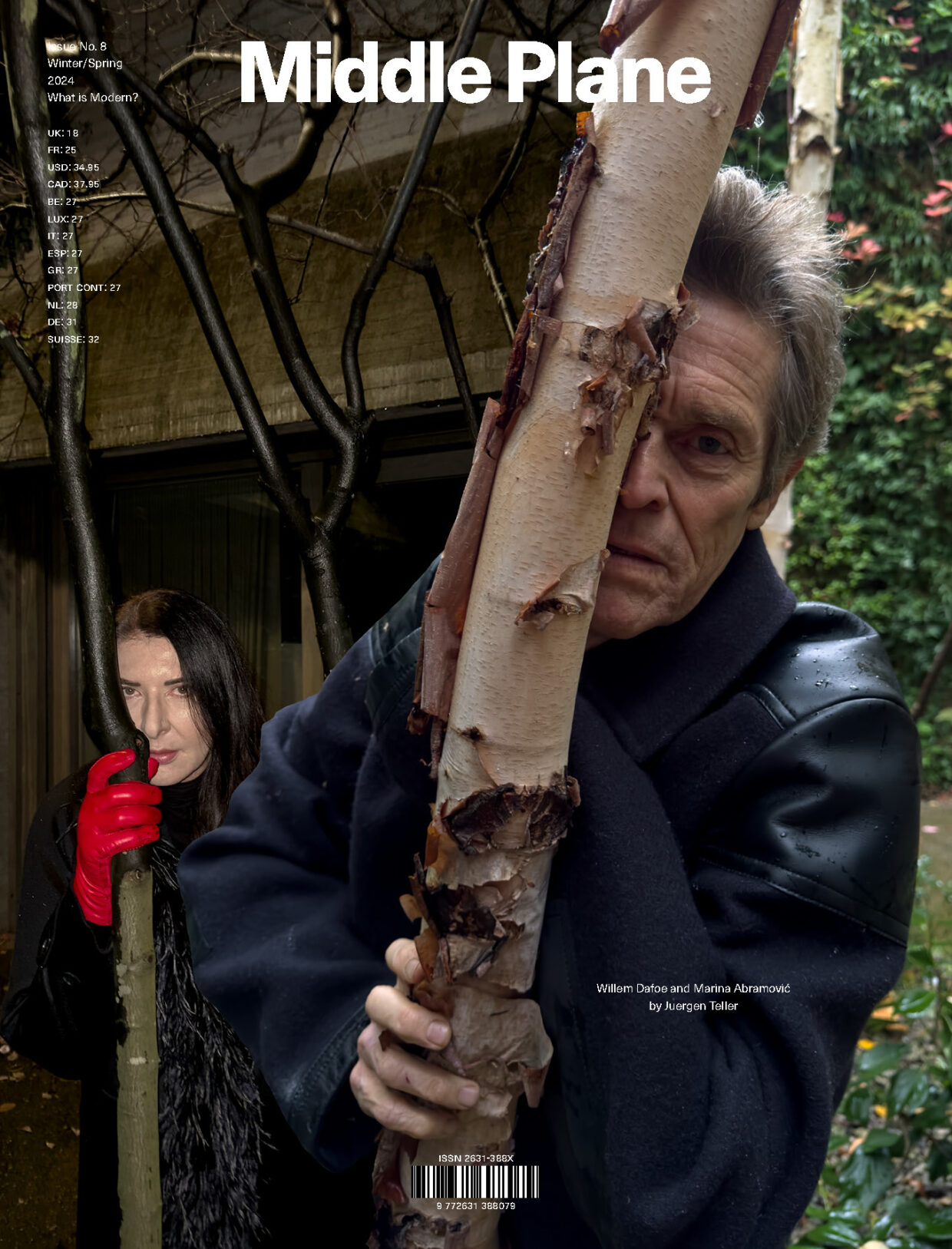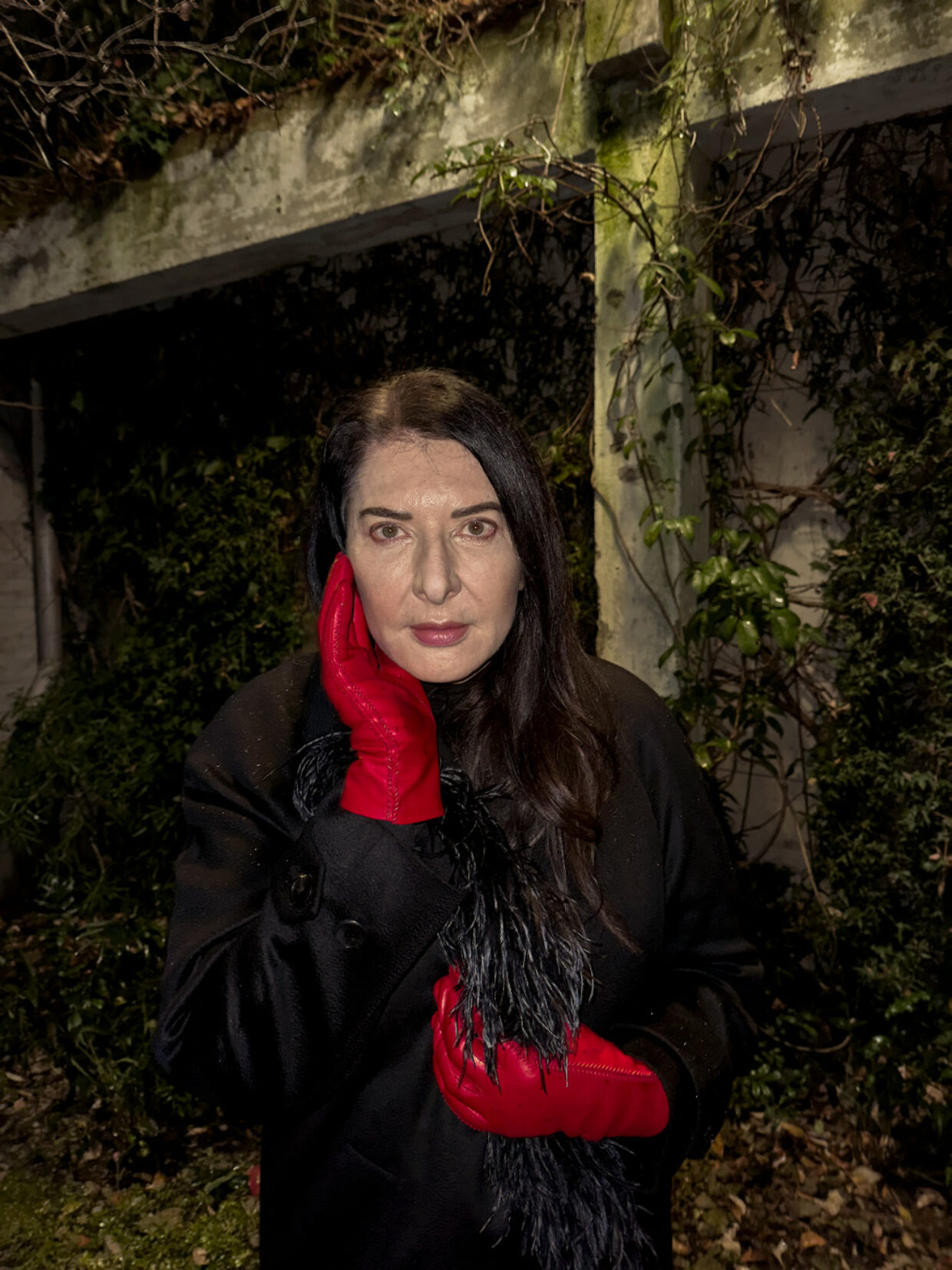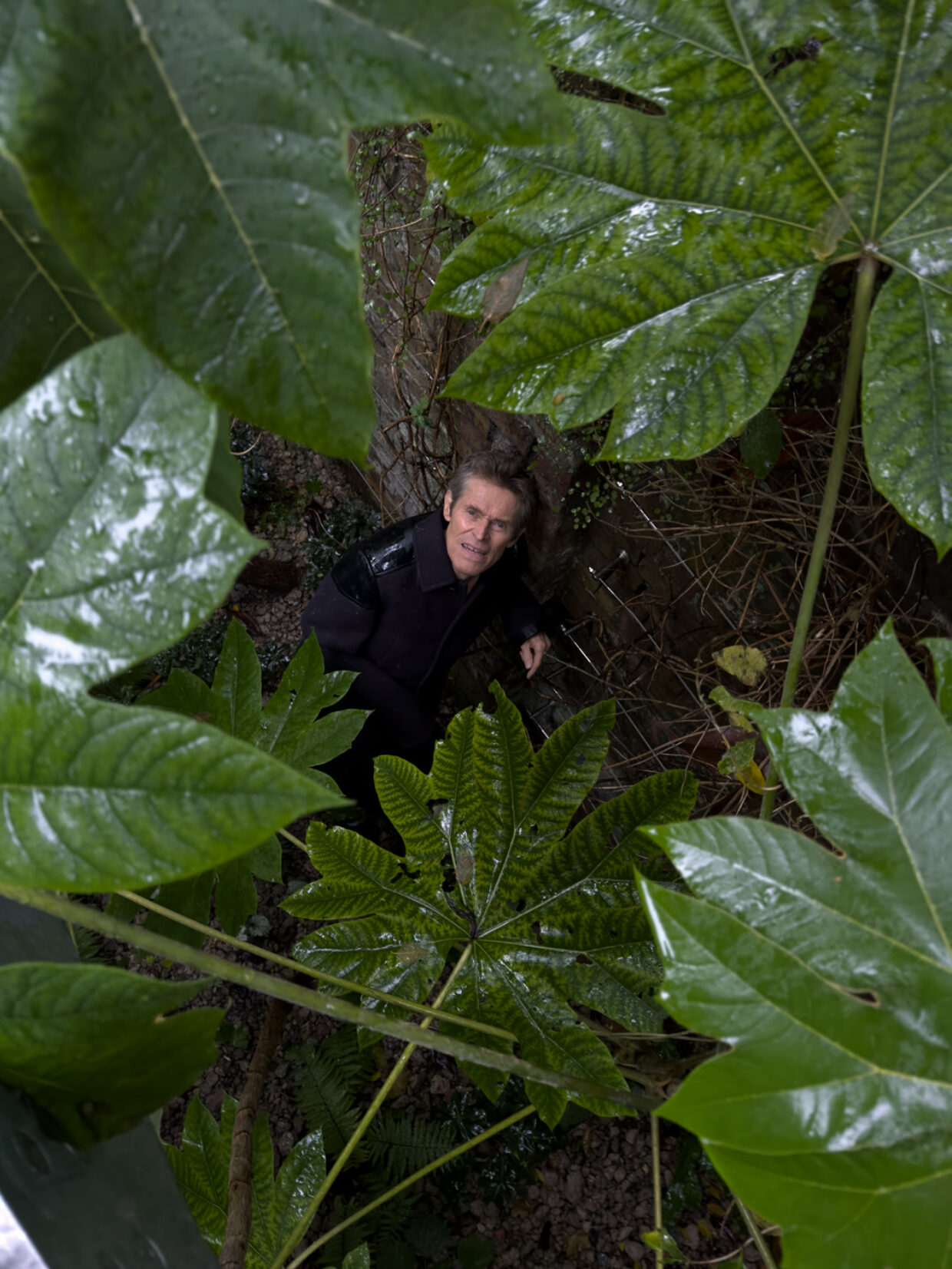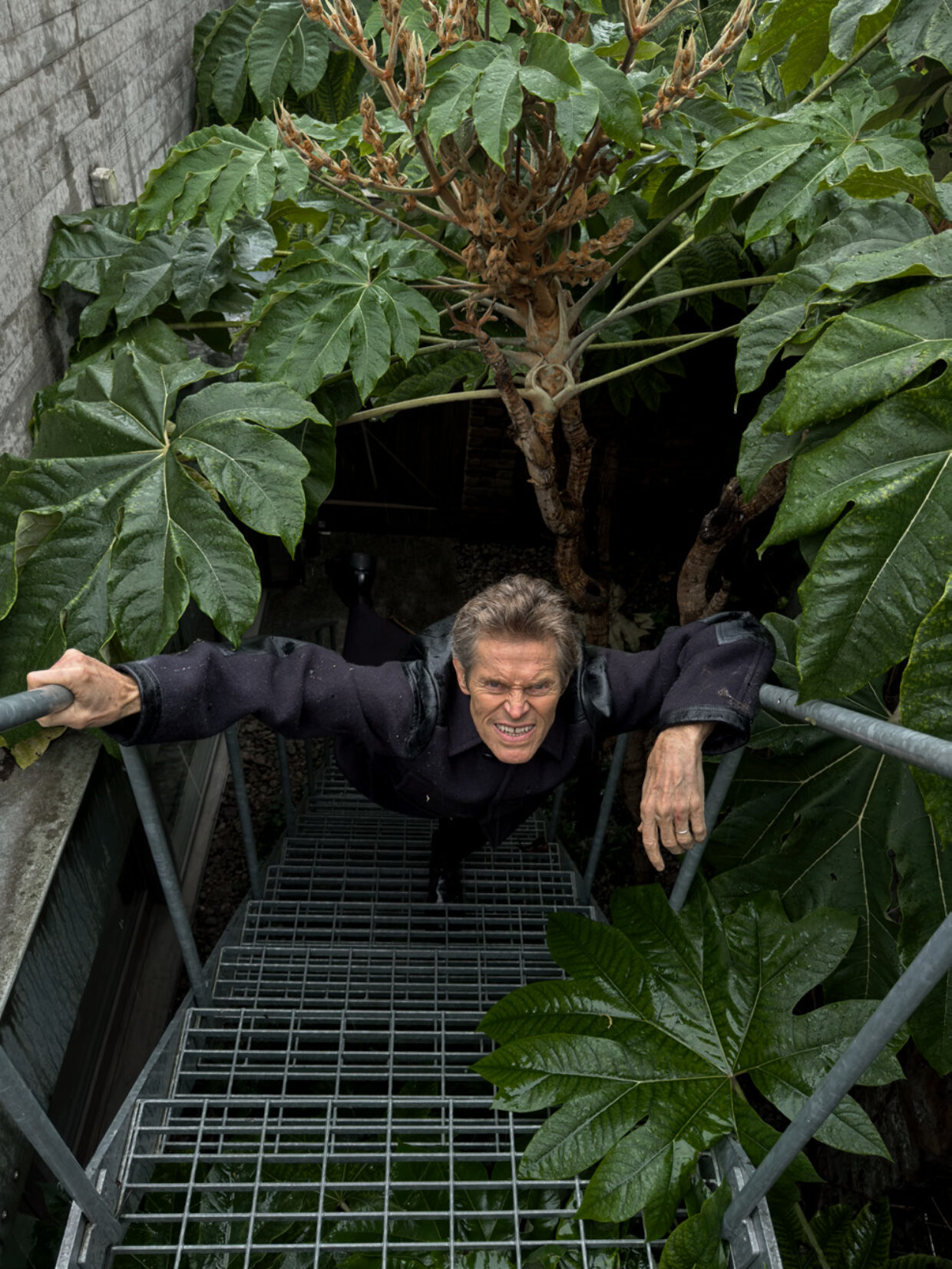Middle Plane Magazine: The 7 Deaths of Maria Callas
Jan. 10, 2024
In an operatic production conceived by performance artist Marina Abramović and co-starring Willem Dafoe, the Greek-American soprano Maria Callas – La Divina – is remembered on stage in London, our home. In a series of short films, 7 Deaths of Maria Callas sees Abramović inhabit the role of Callas, while Dafoe embodies the villain responsible for her death seven times over, in scenes that recreate or interpret the tragic fates of the heroines from La traviata, Tosca, Otello, Madama Butterfly, Carmen, Lucia di Lammermoor, and Norma. In the week of Callas’s centenary, Willem Dafoe and Marina Abramović chatted with Middle Plane contributor Dan Thawley, from Los Angeles and central London respectively, to share their points of view on this monumental collaboration.
dt: Nice to meet you, Willem. Are you in LA?
wd: Yeah I just got here. I’m not usually here, but I’m here today [smiles].
dt: Very good. I’m dialling in from Paris which feels very apt for our Maria Callas themed chat.
wd: Yeah [smiles and laughs] that’s right.
dt: I believe she was born 100 years ago three days ago—
wd: Wow, okay!
dt: —if I’m not mistaken. So there’s been quite a lot of celebrations around that happening here. And when I was asked to have a chat with you about this, I thought it all sounded very serendipitous [smiles and laughs]. The fact that 7 Deaths of Maria Callas has come to London at this point, in the year that marks the 100 year anniversary of her birth, is quite exciting. And it’s a very complex project in a way, it has so many moving parts. I wanted to ask you about your roles in the film and what that was like to create that with Marina Abramović?
wd: I’ve known Marina for many years in many different ways and she just asked me to do this video and she explained … she gave me the broad strokes of what we were going to do. I’ve also worked with Nabil, the director of the videos before, happily, on an ANOHNI song called Cut the World and we shot a video which Marina had a cameo in. That video was very beautiful, so I had a lot of good feelings for Nabil. It was really informed mostly by the costumes and, of course, the music and just … showing up really. There’s no way really to prepare for it, there was usually a concept about what had to happen but my situation was basically to be, as always, material and just kind of support what Marina and Nabil were trying to do.
dt: And for those who haven’t seen the opera, how different are the seven segments?
wd: It’s sort of a single through-line although, I mean, as distinct as the different arias. But we’re really going from space to space to space, changing costumes and, as I say, you’re concentrating on the actions. It’s not like I’m creating a whole character. I’m trying to do the actions as elegantly and assimply as possible. And basically just try to support Marina in it. For those that haven’t seen it, it’s a series of videos where basically I am involved in the death of the heroine [smiles] and each are, of course, arias that are associated with Maria Callas.
dt: And how different is it for you to play a non-spoken word part? Does that change something of your relationship with your character?
wd: Not really. Because words are actions too and I seldom think in terms of psychology directly. So, that’s a pleasure … I mean I’ve said it before but sometimes I feel more like a dancer than an actor – in the sense that I’m not an interpreter. I love doing things and that’s also where I have a connection with Marina’s work, in the respect that I always feel connected to doing things with a very simple intention. And then, in the actual doing, something happens and that really becomes the character. The character’s revealed through submitting to actions, rather than … Often actors are seen as interpreters that are trying to express something they feel about the character, something they think should be conveyed in the story. I relate less to that than, you know, melting into the actions. That’s the best way I can describe it.
dt: If one takes Marina’s very, very abundant and prolific career against yours, do you see parallels between the sort of endurance sport that has so often marked her practice, and what you’ve done on screen and on the stage?
wd: Hard to say [smiles and laughs]. I hate to make a comparison. In a funny way we come from different worlds, but at the same time I feel some sort of kinship with her. In her desire to … Well, let me talk about her. That is; I like her constant effort to challenge herself, which for an actor can sometimes be ridiculous and kind of self-serving. But I relate to it in the respect that the best things happen when you work from a place of not knowing, and you work from a place of challenge. It’s not always that way, it doesn’t always have to be that way. But I find those are the most satisfying because you immediately become active. It’s like you punch your way out of it [laughs]. You find a way, so there’s something, there’s a movement happening, even before you apply yourself because you’ve put yourself in a corner and you have to find your way out. So, I’ve had that all my life. I remember as a child, when the astronauts were going up to the moon and such things. I was very fascinated by that and I used to lock myself in the closet, and this was a private thing, it wasn’t a performance, nobody knew about it. I came from a big family so nobody knew I was doing this but I would lock myself in a closet and see how long I could stay there [smiles] you know … in the dark, by myself [laughs].
dt: [smiles and laughs]
wd: What’s that for? I don’t know. But it was an impulse that I responded to and has something similar to some – I imagine – of the impulses of Marina’s early work. That’s not far-fetched is it? [smiles]
dt: Fantastic anecdote. You’ve played artists in films before, I wanted to ask you a little bit about that as well. At Eternity’s Gate (2018) comes to mind of course. As someone who’s passionate about art yourself and the mind of the artist, how was it to go into Vincent Van Gogh’s head?
wd: Well, that was beautiful because there’s so much material to deal with. His beautiful letters, a lot of biographical material…there was much to study. And then of course you have the paintings. And then you’ve got a painter directing the movie and there’s no stunt painting in it, or a minimum anyway. Between him and a French artist called Edith Baudrand I was really given a crash course on painting, because I had to paint in the movie in real time. In the case of one sequence where I’m painting- in these shoes, it’s kind of like, do or die. If it doesn’t come together at some point I’m exposed as the fraud that I am! But I think it works quite well actually. I don’t like to be proud of stuff, but that’s one thing that was very scary, and I think served its purpose. It came together and sort of gave that painting credibility. I think the most important thing is Julian [Schnabel], in particular, taught me a different way of seeing and I relate it to acting in many ways, I mean … making a mark at a time, it’s like doing an action at a time. And then you do marks next to each other and they start to talk to each other and they start to create a flow. It’s similar with actions. You do actions and then if there’s an integrity to each action, they start to create movement and then they kind of carry you on a wave and you go some place you couldn’t necessarily plan and you don’t necessarily want to plan, as a destination. But you consider all the steps to get there and then, all of a sudden, when you arrive it’s always sort of surprising. So there’s that and then also probably more importantly, he would always say… you know: ‘Don’t think about painting the tree, paint what you see. See the colours, see the light, paint the light.’ That was so useful because it’s a different way of seeing. And what’s special about that, and kind of connects with the deep, spiritual urge that Van Gogh had all his life, is it connects you with this world beyond. Connects you with the origin of all things. Because you’re kind of – deconstructing is too easy a word – dealing with the direct elements of seeing rather than the recognisable things. So you’re taken away from…it doesn’t complete itself, it’s in movement. You start to see…you paint that black, you paint that black, you paint that black, you paint that black, you paint that green, you paint that green, you paint another colour, bop bop bop bop. And it starts to have a life. Whereas if you said: That’s a tree, I’m going to make a good likeness, and you draw it well … that’s less interesting. I mean, this is a pretty rudimentary revelation, but for someone who’s not used to working as a painter, this was quite profound. And I related it to many elements that I’ve experienced performing, so it kind of gave me a good base. Also, it helped me understand so much of what Van Gogh was expressing in his letters. So the painting was the key. Without the painting it would have been a biopic, this is not a biopic, this is … we’re having an experience that’s like a meditation on Van Gogh. We’re trying to inhabit a spirit. And the beautiful thing is we are in the places where he’s painting. So, you have this opportunity where you’re actually seeing what he saw because in that part of France – God bless the French! – because of land management and all that, it hasn’t changed that much. In the States there would be a Mc- Donald’s and a Starbucks, you know? But really, sometimes you could see pretty much a vista that would match the view of a painting that he did. So it was like a conversation with him, it was speaking with the dead … you know … and that’s always a beautiful thing, if you can fool yourself into thinking you’re actually doing it.
dt: I find it very interesting; the fact that At Eternity’s Gate was made by a painter, and the fact that Marina is not known necessarily as a video artist or as someone related to opera, but she was carrying out an obsession, by making 7 Deaths of Maria Callas. When you think back to things like Ballet Russes, for example, as this melting pot of artistic voices … Like a salon, let’s say. Artists who would do the costumes, artists who would paint the backdrops, and all of those different things. These were all defining ideals of modernity in the twentieth century. It’s interesting to continue that culture now in projects like these. And I think it’s why it’s so interesting to see, you know, yourself, as part of something that’s showing in operas around the world. I wanted to ask you what you thought about participating in alternative spaces to what may be your traditional role, as a way of carrying that legacy of modernity forward.
wd: My traditional role is fluid, I identify fluidly in my work [smiles and laughs]. Because I come from a tradition where … first of all, I came of age as a performer in a very interesting time in New York and, I don’t want to get sentimental, but it truly was interesting. You talk about that salon … there wasn’t quite a salon because the truth is I was working at a theatre company and we were locked inside those doors doing our work. But with time … we were doing work that wasn’t career oriented and, also, it was for now. We always treated every piece like it was going to be our last. The people didn’t train in those disciplines, often it was a reach. And the aesthetic was almost like an amateur aesthetic in the sense that we did it because we loved to. And it was like a community theatre, but our community was SoHo at a time where it was predominantly artists. So, initially, we worked very hard and then once we found some kind of visibility, people would start to see our work and there was some sort of exchange. There were art students that went there to be painters but that ended up making bands, there were dancers that were making films, there were film-makers that were making theatre, or music. It was all mixed up. So I sort of come from that tradition. And now, working even in more traditional Hollywood film structures, I always approach it as a great collaboration. I look at the whole thing and try and see myself in the context of being just one element that’s going to meld with these other things. And I think one of the biggest jobs I have, when I get there, is to see what we’re doing, to look around and see what other people are coming to this place with. That’s the pleasure and that’s a huge part of my job. Going towards the way of other peoples’ seeing, and being material, and making that flesh. That’s the exciting thing about being an actor for me.
dt: How did you approach becoming a part of someone else’s artwork and taking directions from somebody who is themselves a performer and who is very familiar with their own body and the body.
wd: Not only had I known Marina for a while, she was my neighbour, we had many common friends, my wife knew her ever since she was a young girl. There were many connections I had with her and then we did the Bob Wilson piece, called Life and Death of Marina Abramović (2012). In which I played most of … well all of the male figures in her life. So there we go again! It was really an extension of that. Her Royal Academy show isn’t totally exhaustive – for example, it doesn’t mention some of her work with Bob Wilson, or, for that matter, her work with my wife [Giada Colagrande, dir. The Abramović Method, 2013] – but it was really good in the way it chartered that certain changes in her life pushed her to different ways of working. Life and Death of Marina Abramović really was a time where she was abandoning certain dictates or principles of performance, and hopping into theatre. Theatre, something that she was always repelled by because it was artificial. It was about artifice. And also she was revealing her personal life in a way that was more evident. Less poetic and maybe more … I don’t know [laughs] … prosaic, in the respect that we were getting real information about her personal life. So, I was part of that, seeing her go through that and I think it was very emotional for her and it was a little bit of a risk. But also I think, was a way for her to deal with her … I won’t say newfound celebrity. But I think, in the time I’ve known her I’ve seen her go from a very respected artist’s artist to someone who has ended up in popular media. People know who she is. I think largely due to something like The Artist Is Present (2012), which was quite an event, and the mainstream press really latched onto that as a piece. So, it’s all a soup and it’s just about being there for Marina because I admire her, I admire the way she turns the pain of her life into positive things and the way she is always working. I like this idea of the line being blurred between your life and your work and having one feed the other. Not in always a transparent way but at its base there’s no difference. You’re always working, you’re always living.
dt: How long ago did you move to Rome?
wd: You know … I still keep a place in New York but basically I met Giada 20 years ago … maybe 21 years ago. At the beginning we were splitting time between the two cities and now the balance is a little more towards Rome.
dt: I mean that’s a city that’s also filled with operatic notions—
wd: [nods] God, oh God!
dt: —which are incredible, incredible stories that are very much in the Callas vein.
wd: Sure! And then also the other connection I had with Callas is the Pier Paolo Pasolini connection. I made a movie about Pasolini and of course, while she’s not featured in that, we thought about her a lot.
dt: Yes, his ghost is everywhere in Rome still, isn’t it?
wd: It’s true, it’s true. And the beauty of that film is that the family was very generous with us. Ninetto Davoli participated. I was wearing his [Pasolini’s] clothes that Ninetto gave me. We were filming in the actual places where he was. This is not a method thing actually, it’s that we’re using these places just as touchstones. They’re like …
dt: Genius loci?
wd: Yeah.
dt: The spirit of the place. In this project you were wearing some pretty fabulous costumes by Riccardo Tisci. Can you tell us about them, and your relationship to fashion?
wd: Sure. I’m an actor and I value a costume very much … so, I know how clothes can transform you. I know how they can make you think differently, I know how they can make you feel differently, I know how they can be political. When I’m sitting around in a place that has fashion magazines, I go through some of the photos and they’re really entertaining and fun. I enjoy them! So on some level, I appreciate fashion. And I love shooting with … dressed in other people’s clothes and kind of making them work. It’s kind of like an instant collaboration between the designer, my body, myself, the photographer, all that, in a very short amount of time. And you have to come together. I like that! It’s fun! Making shapes, seeing what possibilities exist within the clothes, having a reaction to them, but trying to meet them somewhere. But then I also feel funny because in my life … I live a pretty nomadic life … look right here [points to suitcase], I live out of a suitcase. I always have anxiety when I go someplace and I tend to really opt for a uniform and keep it pretty simple. Black, black, black, black, black! [laughs] Pretty simple stuff, don’t overreach, don’t get too casual, don’t get too formal. So I’m not a person that lives in fashion all the time and the truth is … I admire … I’ve got some friends who are real dandies, they love to dress up. It is an expression of how they feel. They are constructing something and it becomes a work of art for them, they become a work of art! I feel like that less in my private life. I have a lot of respect for really good designers, just like the art world, I’m attracted to it and sometimes it inspires me even more than cinema or theatre because, yes, there are restrictions, but it pretty much has no rules. And going back to things being modern, there’s kind of a challenge to define yourself in relationship to the past and to – not provoke for provocation’s sake – but to push what the possibilities are. About how we see, how we live, how we dress, all those things. And for me, that’s the exciting part of being a performer. Because you’re engaged in that kind of questioning that I don’t think is necessarily a natural impulse in people, or, at least, society doesn’t encourage it. So as long as you can keep that kind of questioning, and that kind of curiosity and that kind of wonder alive, then you’ve got something. And you’re living a life that hopefully contributes and also elevates, just the time you’re here.
dt: That’s beautiful. Thank you for that insight. And the garments you wore in this particular production. Was there a highlight for you?
wd: I’d say the gold dress takes the crown, and then maybe the hazmat suit [laughs].
dt: Sure, and now that the strikes are sort of coming to an end, are you in the US for a new film?
wd: Yeah, I’m very excited because this week there is the premiere of Poor Things, the Yorgos Lanthimos film, in New York.
dt: Oh, so excited to see it, I haven’t seen it yet!
wd: I think it’s beautiful. Talk about collaboration, talk about each department contributing to make a world! The costumes are beautiful, the music is beautiful, the sets are beautiful. It’s very well made and Yorgos is just … he’s just …
dt: A maestro?
wd: Yeah! It’s quite specific. You know I’m always attracted to people with a specific vision and he has that. And he’s also not an asshole! He’s a sweet, very cultured, very smart, very playful guy. But he has a deep curiosity and openness that really inspires you to meet him there.
dt: Well, thank you so much for your time. Really appreciate it! Have a great day in LA and until soon in the streets of Rome!
wd: Alright, great, take care. Ciao ciao!
Source: Middle Plane Magazine





